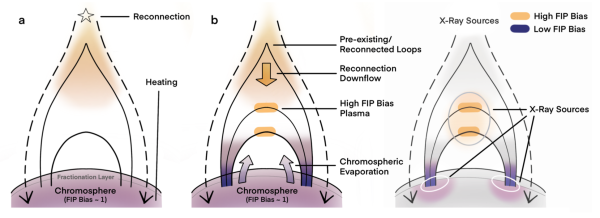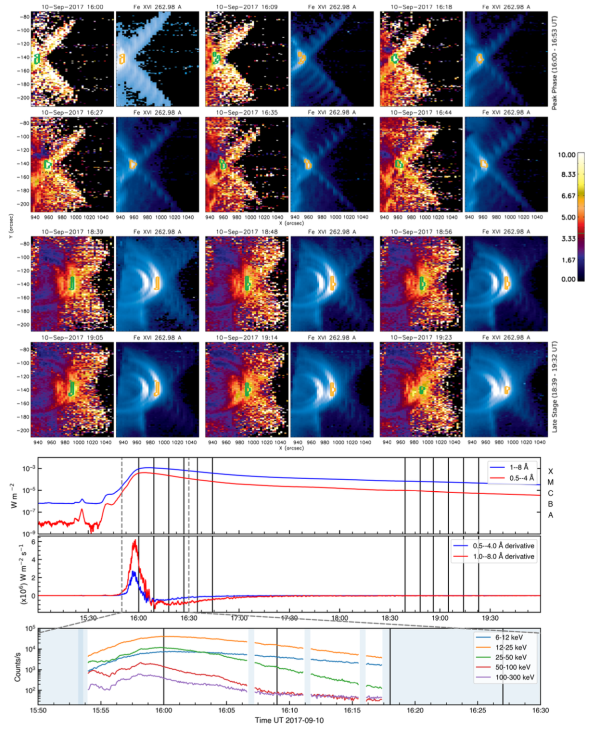Spatially resolved plasma composition evolution in a solar flare
| Nugget | |
|---|---|
| Number: | 476 |
| 1st Author: | Andy S. H. TO et al. |
| 2nd Author: | |
| Published: | |
| Next Nugget: | Return currents |
| Previous Nugget: | HOPE during high activity |
Introduction
Solar flares can significantly affect the elemental composition in the corona. The observed variations of elemental abundances reflect the First Ionization Potential (FIP) effect, where easily ionized elements (low FIP, < 10 eV) such as Ca and Fe show abundances that are relative to high-FIP elements (≥ 10 eV) like Ar and S. The ratio between coronal and photospheric abundances of these elements, known as the "FIP bias," helps us understand the physical processes occurring during flares. Previous studies using Sun-as-a-star measurements often show photospheric abundances during flares, suggesting that chromospheric ablation pulls up low and high-FIP element indiscriminantly. The spatial variation of composition within flare structures has thus remained poorly understood (e.g., Ref. [1]).
Observations
We have analyzed the famous flare SOL2017-09-10 (X11.9) using the Hinode/EIS instrument, which provided 12 spectroscopic observations spanning 3.5 hours (Ref. [2]). Using both Ca XIV/Ar XIV and Fe XVI/S XIII composition diagnostics, we found consistently that:
- The flare loop tops maintained high FIP bias values (> 2-6) throughout the observation period for both Ca/Ar and Fe/S;
- FIP bias gradually decreased from loop tops toward footpoints, reaching photospheric values (FIP bias ~ 1);
- The temporal evolution showed higher FIP bias during the peak phase, gradually decreasing in later stages.
These maps show FIP enhancements at the loop tops, closely matching the images themselves; the footpoints of these loops instead have normal photospheric abundances.
Discussion and Conclusions
to explain this striking discovery, we propose a scenario similar to that for the loop plasma itself. The persistent high FIP bias at loop tops results from plasma downflow from the plasma sheet, where pre-existing coronal loops with high FIP bias undergo reconnection; see Ref. [1] for a description of composition in this current sheet. This highly fractionated plasma (FIP bias > 2) becomes confined at loop tops, while chromospheric evaporation fills the lower parts of loops with unfractionated plasma (FIP bias = 1).

Our observations provide new insights into flare heating mechanisms and the formation of bright loop-top "EUV knots" - dense plasma concentrations commonly observed at flare loop tops. While the standard flare model suggests heating through chromospheric evaporation, our composition measurements reveal that flare heating is more complex, involving both directly heated coronal plasma and evaporated chromospheric material.
The high FIP bias we observe at loop tops contradicts models where EUV knots form solely through colliding evaporation flows, as such flows would carry photospheric composition plasma. Instead, our results support scenarios where reconnection outflows contribute to the formation of these bright loop-top features.
This scenario helps explain several key observational features:
- The spatial gradient in composition along flare loops - from
highly fractionated plasma at loop tops to photospheric values at footpoints
- The remarkable persistence of high FIP bias at loop tops over 3.5
hours - maintained by continuous downflows from the current sheet
- Why Sun-as-a-star measurements typically show photospheric
abundances - the localized high FIP bias at loop tops is diluted by bright footpoint emission in spatially-averaged observations
- The formation mechanism of bright loop-top "EUV knots" - these
features arise from confined, highly
Our findings demonstrate that flare plasma heating is more complex than previously thought, involving both directly heated coronal plasma and evaporated chromospheric material. This dual heating mechanism provides new insights into how energy is transported and dissipated during these powerful solar events, and highlights the importance of spatially-resolved observations in understanding flare processes.
For more details, see Ref. [2].
Acknowledegement
This Nugget and Ref. [2] are the work of the author and colleagues David H. Brooks, Shinsuke Imada, Ryan J. French, Lidia van Driel- Gesztelyi, Deborah Baker, David M. Long, William Ashfield IV, and Laura A. Hayes
References
[1] "Photospheric and Coronal Abundances in an X8.3 Class Limb Flare"
